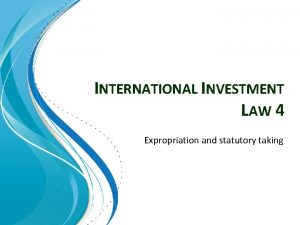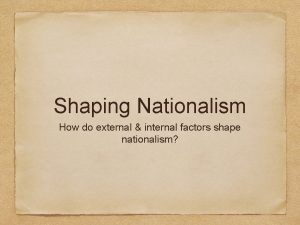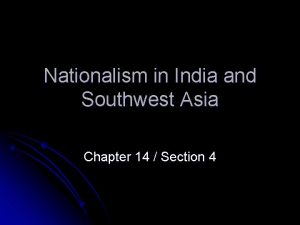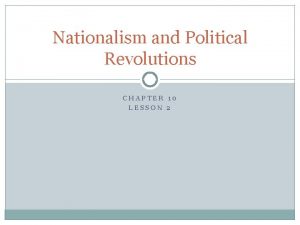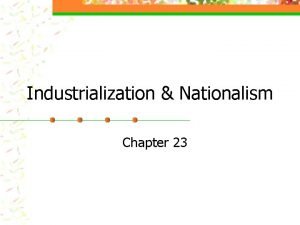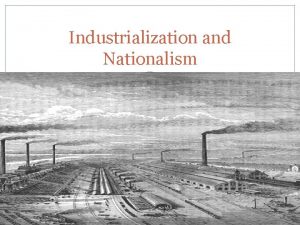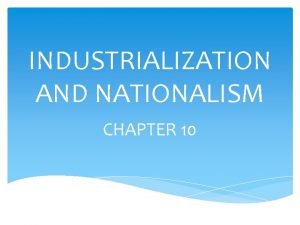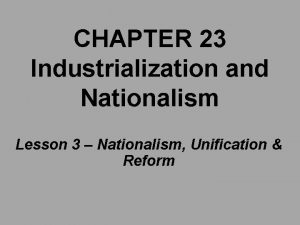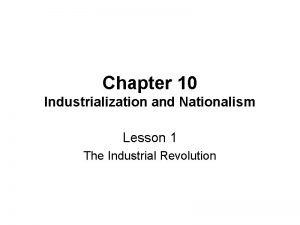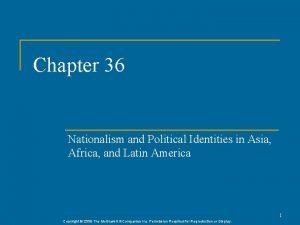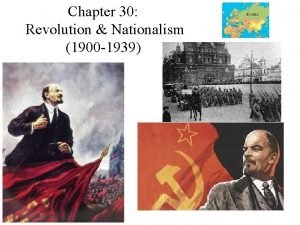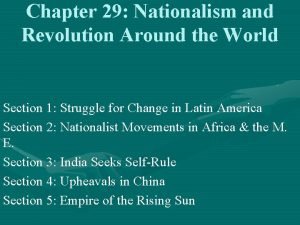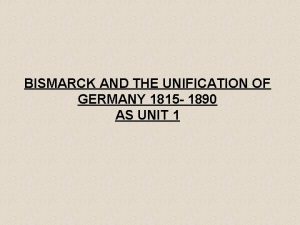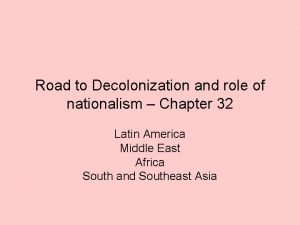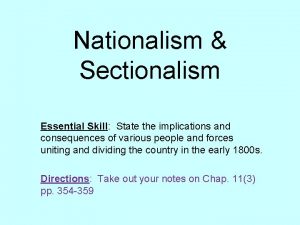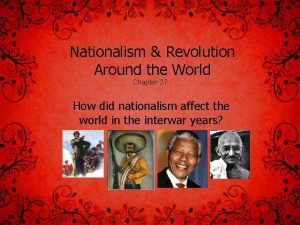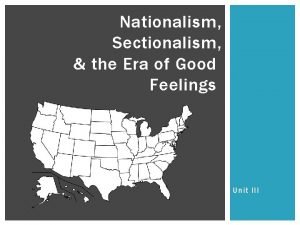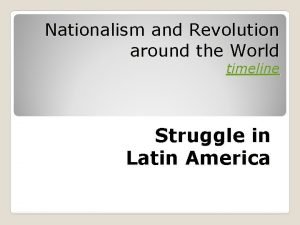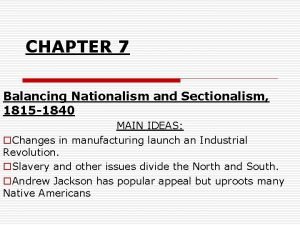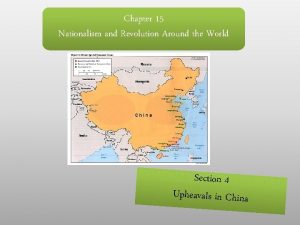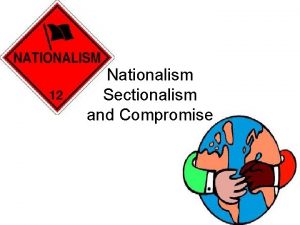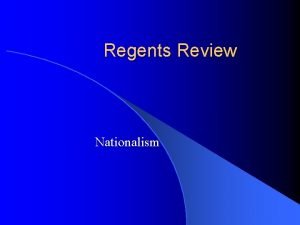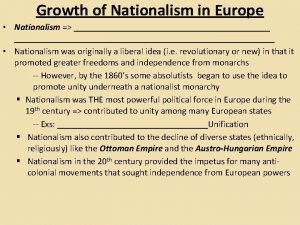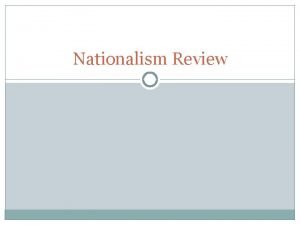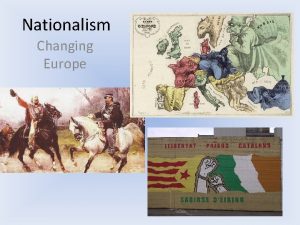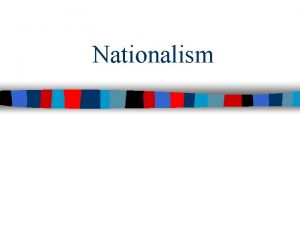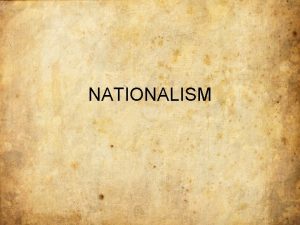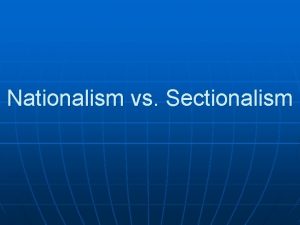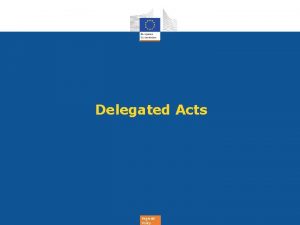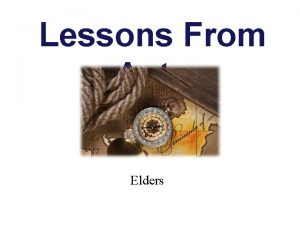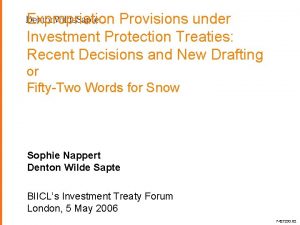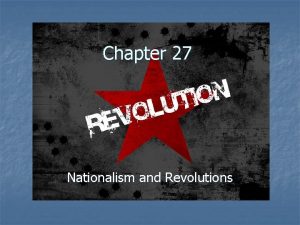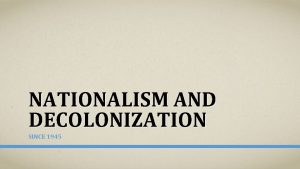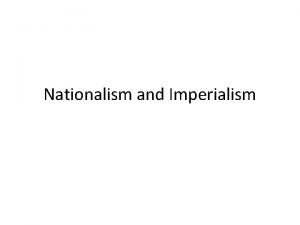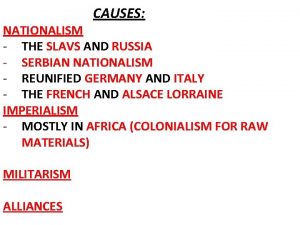Resource Nationalism and Expropriation Recent Expropriation Acts in
















































- Slides: 48

Resource Nationalism and Expropriation

Recent Expropriation Acts in Oil Industry number of acts 19 59 19 62 19 65 19 68 19 71 19 74 19 77 19 80 19 83 19 86 19 89 19 92 19 95 19 98 20 01 16 14 12 10 8 6 4 2 0

Oil price and expropriations Number of expropriations in the oil industry and the oil price shock (deviation from the long-term price trend) in 1910 -2006. oil price 120 100 80 60 40 20 75 19 79 19 83 19 87 19 91 19 95 19 99 20 03 20 07 71 19 67 19 63 19 59 19 55 19 19 19 51 0

Indirect Expropriation u Direct government seizure of foreign investors’ property lacks sophistication and is largely a thing of the past. u Indirect expropriation: examples n n n Declaration of the land where the investment was to take place as an area for the protection of a rare cactus, coupled with the denial of a construction permit Interference by a government regulatory authority, enabling the domestic investor to terminate a contract, basic to carrying out the investment, by the foreign investor Revocation of an operating license of a landfill Excessive or arbitrary taxation, making the investment economically unsustainable Revocation of a free-trade zone certificate causing import prohibition Imposition of managers designated by the host government

Expropriations including indirect ones ICSID Cases by Year (cases) 40 35 30 25 20 15 10 5 0 1972 1977 1982 1987 1992 1997 2002 Source: International Centre for Settlement of Investment Disputes (ICSID) 2007

Questions u Why countries expropriates private properties of foreigners? u What are the benefits and costs? u In which economic and political situations do governments tend to expropriate private properties of foreigners? u What are the measures for the foreign investors to defend against expropriation by the host countries?

Expropriations in Latin America u. Inflow of foreign capital u. Emergence of leftist governments u. Increase of the commodity prices

FDI Flows 2000000 120000 1800000 1600000 80000 1200000 1000000 60000 800000 40000 600000 400000 200000 0 70 19 73 19 76 19 79 19 82 19 85 19 88 19 91 19 94 19 97 20 00 20 03 20 06 0 19 $million 1400000 World Latin America

Resource Nationalism: Background Late 1960 s to early 1970 s Political Background - Liberalization from the advanced countries (end of WW 2) → rise of nationalism - Rising status of the new born countries 2000 s - Anti-Americanism Leftist Government - Rising influence of the developing countries (BRICs) → political influence of the advanced countries like U. S. has decreased - Dissatisfaction with the reforms based on Washington Consensus Economic Background - accumulated complaints - Continuous concerns about the concerning the fall of raw material scarcity of natural resources prices → rising competition among advanced countries for resource insurance

Expropriations in Latin America Nationalization Venezuela PDVSA • Changing oil field contracts of 32 MNCs possessions so that the government acquires more than 60% of property. (2006) • Increasing the royalty(16. 6%→ 33. 3%) and the income tax (34%→ 50%) that levy on private oil companies. Petroecuador Bolivia • Requiring new contracts that transfer ownership of oil and natural gas industry to Bolivian state enterprise YPFB. (2006) • Levying 82%(50% before) of tax for the excess natural gas YPFB (Production per day is 100 million feet cube). Ecuador • Passing a bill that oil companies should secure 50% profits of Ecuadorian government.

Expropriations in Latin American Cases in ICSID 39 % 61% Argentina Venezuela Panama Guyana Papua New Guinea Bolivia Chile Costa Rica Ecuador El Salvador Honduras Guatemala Nicaragua Paraguay Peru Mexico Rest Source: ICSID 101 ICSID Cases out of a total 295 are related to Latin America. (2000 -7)

Expropriations in Latin American Cases in ICSID cases 50 40 30 20 10 Pe ru M ex ic o Ri c Ec a ua El do Sa r lva H dor on du r G ua as te m a Ni ca la ra gu Pa a ra gu ay le hi C os ta C liv i a ne ui G w Pa pu a Ne Bo an a a G uy na a Pa el zu m a in ne nt Ve ge Ar a 0 Source: ICSID Argentina 46, Mexico 13, Ecuador 9, Venezuela 9, Peru 7

Expropriations in Latin American Cases 2000 -2007 Telecommunication Oil Gas Electricity Mining Water 0 2 4 6 8 10 12 14 16 18 Source: ICSID From 2000 to 2007, 49 Latin American cases out of 85, were about natural resources. (cases)

Theory and Evidence

Theory of Expropriation u Assumptions: n n Host country expropriates if the income with expropriation is larger than the income without. With expropriation, production decreases as the managerial skill is withdrawn out of the country. u Results n n The threat of expropriation can significantly distort the international allocation of capital even if the act of expropriation is relatively rare. The ability of a country’s government to expropriate foreign investments may actually reduce its welfare.

Literature u Kobrin (1985) emphasizes that once one government expropriates, there is a visible “domino effect”. Other oil-exporting governments learn from the experience. u Moran (1973) describes how international treaties may increase costs of expropriation. u Bohn and Deacon (2000) shows that if there is a risk of expropriation, firms underinvest in long-term production capacity, while trying to extract and sell resources inefficiently early.

Observations u. The nationalization of oil companies takes place when oil prices were high. n Most expropriations took place in 1970 s, when oil prices were at historically high levels. Once the oil price came down in the 1980 s and 1990 s, the expropriations virtually disappeared and reemerged only in the last decade when oil prices climbed back to 1970 s levels.

Hypothesis u The higher the oil price, the more valuable the oil assets and the stronger the incentives to expropriate. u Expropriation is more likely whenever there are fewer checks on the government so that the latter finds it hard to commit. u An increase in the managerial and technical capabilities of oil-producing countries increases the government’s outside option in the case of expropriation and thus increases the risk of expropriation.

PV of government income Value of product Government income With expropriation time

Higher price Value of product Government income With expropriation time

More unstable government Shorter time horizon Value of product Government income With expropriation time

Increase in the managerial and technical capabilities Value of product Government income With expropriation time

Empirical analysis u First, a positive oil price shock increases the risk of expropriation. u Second, weak political institutions increase the risk of expropriation. u Finally, the level of human capital development may also affect the risk of expropriation. n On the one hand, the government’s ability to invest efficiently increases the risk of expropriation. On the other hand, a higher level of human capital allows the government to collect more taxes, thus eliminating incentives to expropriate, rendering the effect of human capital on expropriation ambiguous.

Data u. The study includes the period of 19602002, during which period there have been 94 expropriations in 40 countries. u. Most nationalizations were concentrated in 1970 s.

Major events affecting the international oil price changes

Expected results u. Executive constraints (-) u. Democracy (-) u. Human capital: adult literacy (? ) u. GDP per capita

Summary statistics for expropriations and non-expropriations

Logit pooled regressions

Logit pooled regressions for countries with at least one expropriation

Logit panel regressions with country fixed effects

Implications u Kobrin found that expropriations declined overall in the late 1970 s and forecast that the rate of expropriations would continue to be low. u Nationalization of industries where ownership was of the essence (mining, petroleum) was virtually complete by 1976. u As time since independence passed, many developing countries (LDCs) experienced growing confidence in their identity and attitudes toward foreign firms became more pragmatic. Regimes began to view foreign direct investment (FDI) as a package of benefits and costs whose relation could be manipulated.

Implications u The administrative, managerial, and technical capabilities of host countries improved significantly. Regulatory control of behavior was perceived to be more effective and efficient than expropriation, and bargaining power was sufficient to give policymakers confidence in their ability to enforce behavioral controls. u International economic conditions in the late 1970 s increased the benefits of FDI on the one hand limited the freedom of action of some LDCs on the other. The oil price increases in 1973 and 1979 and the resulting worldwide recessions exacerbated balance-of-payments problems of non-oil LDCs and increased demand for inflows such as FDI. Sharp increases in foreign debt among many countries may also have limited freedom of action in this area.

Implications u Other indications that the symbolic elements of the LDC-MNC relationship have largely given way to instrumental elements include: 1. 2. 3. passage of laws making expropriation illegal; the commitment of many LDCs to the principles of the Multilateral Investment Guarantee Agency (MIGA) and Overseas Private Investment Corporation (OPIC); and privatization.

Protective Measures

Protective Measures 1. Under International Organizations WTO • Investment-related measures exist under WTO in a fragmented matter. (TRIMs, GATS, TRIPs, ASCM) • TRIMs : Scope of application is limited to investment measures in goods trade • GATS : Investment liberalization and protection 4 types of services including commercial presence - Weak investment protection and no direct clauses on expropriation and compensation

Protective Measures 1. Under International Organizations • WTO Investment-related Dispute Settlement - No dispute resolution system is available for investmentrelated disputes exclusively. - All disputes are supposed to be settled in accordance with DSU (Dispute Settlement Understanding) - State-State dispute settlements only (vs. dispute settlements in BITs/ FTAs)

Protective Measures 1. Under International Organizations MIGA • Multilateral Investment Guarantee Agency established in 1988 under the World Bank • 171 member states as of 2007 including Korea and a majority of Latin American/Caribbean Countries • Investment insurance services against political risks (direct/indirect expropriation, etc. ) • Mediation service in disputes between investors and states

Protective Measures 1. Under International Organizations MIGA Conflicts (breach of contract, expropriation) Investor State Good offices Claim Decision by MIGA

Protective Measures 1. Under International Organizations MIGA Argentina : Jan, 2004 Claim on expropriation → 40 % of the claimed amount paid to the investor, Feb 2005 Nicaragua : Nov, 2006 Claim on expropriation →MIGA in investigation of facts and in discussion with Nicaraguan government Source : MIGA annual report 2007

Protective Measures 2. Under FTAs NAFTA / DR-CAFTA • Various FTAs and RIAs have started to include investment chapters with the agreement since NAFTA • Especially, RIAs in the Americas have followed the NAFTA model which was designed according to the US BIT model. – Mexico-Japan • Clauses on expropriation or free transfer appear to be similar to those of Bilateral Investment Treaties • In General, FTAs and RIAs prohibit direct and indirect, creeping expropriations except for a) a public purpose b) a non-discriminatory basis c) due process of law d) payment of compensation • Investor-State dispute resolution systems are available through which investors can submit a claim to international arbitration

conflict Y Settled Consultation & negotiation Investor-State Dispute Settlement under NAFTA N Notice of intent DR-CAFTA : similar process except for differences in article 1020, 1021, annex 10 -F Submission of a claim to arbitration Notice N Nomination of Arbitrators Y Consent to nomination Arbitration Final Award Secretary General Specific features of arbitration process, transparency, appellate body

Protective Measures 3. Under BITs l BITs in Latin America - Mexico : 23 countries - Brazil : 14 countries - Argentina: 59 countries - Venezuela: 26 countries - Bolivia: 14 countries, not entered in force l BITs between Korea and Latin American Countries - Korea has signed 16 BITs with Latin American Countries including Bolivia, Nicaragua, Argentina and Mexico since the BIT with Paraguay signed in 1992

Protective Measures 3. Under BITs • BITs generally include clauses which prohibit direct and indirect expropriation or nationalization. • Specific descriptions on indirect expropriation are found in BIT between US and Uruguay as in the case of DR-CAFTA while other BITS generally do not include such descriptions. • BITS also include dispute settlement measures - dispute between investor and state - dispute between states • BITs signed in relatively earlier decades include rather brief clauses of dispute settlement. But, in the recent BITS, those clauses tend to be more specific, which are similar to those in FTAs/RIAs such as NAFTA

Protective Measures 4. International Commercial Arbitration ICSID u ICSID is an autonomous international institution established under the Convention on the Settlement of Investment Disputes between States and Nationals of Other States (the ICSID or the Washington Convention) with over one hundred and forty member States. u The ICSID Convention is a multilateral treaty formulated by the Executive Directors of the International Bank for Reconstruction and Development (the World Bank). It was opened for signature on March 18, 1965 and entered into force on October 14, 1966. u However, ICSID does not conciliate or arbitrate disputes; it provides the institutional and procedural framework for independent conciliation commissions and arbitral tribunals constituted in each case to resolve the dispute. u Arbitration by ICSID is less expensive than by regular court, and its efficiency is much higher. For these reasons the use of ICSID has increased sharply from 1997.

4. International Commercial Arbitration ICSID u On May 2, 2007, the World Bank received a written notice of denunciation of the ICSID Convention from the Republic of Bolivia. u Brazil and Mexico have not assigned to ICSID convention, while Canada is on its process. Therefore, ICSID Convention will be important in NAFTA which Canada, the US and Mexico are involved. (Up until now, 12 disputes in NAFTA have been resolved by ICSID Additional Facility Rules) u Up until 2007, 259 cases have been treated in ICSID.

4. International Commercial Arbitration LCIA u The London Court of International Arbitration (LCIA) is one of the longestestablished international institutions for commercial dispute resolution. u Although based in London, the LCIA is a thoroughly international institution, providing efficient, flexible and impartial administration of dispute resolution proceedings for all parties, regardless of their location, and under any system of law. 4. International Commercial Arbitration ICC u International Court of Arbitration of International Chamber of Commerce (ICC) is an international economic institution for resolving international commercial and business disputes. u The total number of cases handled by the Court since it was founded is more than 15, 000. In 2006 alone, 593 cases were filed, involving 1, 613 parties from 125 countries.

5. Others OPIC u OPIC is an independent U. S. government agency whose mission is to mobilize and facilitate the participation of U. S. private capital and skills in the economic and social development of less developed countries and areas, and countries in transition from non-market to market economies. u OPIC assists U. S. companies by providing financing (from large structured finance to small business loans), political risk insurance, and investment funds. OPIC complements the private sector in managing risks associated with foreign direct investment and supports U. S. foreign policy.

- Foreign direct investment is strongly inclined by size of the market, cheap labor, reserves of natural resources, and overall efficiency of production. - Korea’s investment in Latin America is mostly concentrated on i n s u r i n g t h e s u p p l y o f n a t u r a l r e s o u r c e. - However, the political risks of Latin America is hindering the - How ever, the political risks of Latin America is hindering the e f f i c i e nefficiency of foreign investment in the region. - It is strongly recommended for the investor countries to perceive the risks of the country and provide adequate protection measures.
 Expropriation in international investment law
Expropriation in international investment law What is the role of modifiers of human acts
What is the role of modifiers of human acts Resource allocation vs resource leveling
Resource allocation vs resource leveling Perbedaan resource loading dan resource leveling
Perbedaan resource loading dan resource leveling Recent trends in ic engine
Recent trends in ic engine Recent developments in ict
Recent developments in ict Recent developments in object detection
Recent developments in object detection Many recent college graduates have faced
Many recent college graduates have faced Recent trends in foreign trade
Recent trends in foreign trade Skimming techniques include
Skimming techniques include Recent trends in project management
Recent trends in project management Recent demographic changes in the uk
Recent demographic changes in the uk Powerschool myips
Powerschool myips Stippling
Stippling Jose has just played a long bruising football game
Jose has just played a long bruising football game A friend emails you the results of a recent high school
A friend emails you the results of a recent high school Recent advances in ceramics
Recent advances in ceramics Active voice headlines
Active voice headlines Https://drive.google.com/drive/
Https://drive.google.com/drive/ Recent amendments in companies act
Recent amendments in companies act Emerging trends in mis
Emerging trends in mis Mpgu
Mpgu Internal and external factors of nationalism
Internal and external factors of nationalism Nationalism in india and southwest asia
Nationalism in india and southwest asia Lesson 2 nationalism and political revolutions
Lesson 2 nationalism and political revolutions Lesson quiz 23-2 industrialization and nationalism answers
Lesson quiz 23-2 industrialization and nationalism answers Chapter 10 industrialization and nationalism
Chapter 10 industrialization and nationalism -have strength to match the growth of industrialization
-have strength to match the growth of industrialization Chapter 35 nationalism and political identities in asia
Chapter 35 nationalism and political identities in asia Chapter 23 lesson 3 nationalism unification and reform
Chapter 23 lesson 3 nationalism unification and reform Industrialization and nationalism lesson 4
Industrialization and nationalism lesson 4 Chapter 36 nationalism and political identities in asia
Chapter 36 nationalism and political identities in asia Chapter 30 revolution and nationalism worksheet answers
Chapter 30 revolution and nationalism worksheet answers Define cavour
Define cavour What's the difference between nationalism and sectionalism
What's the difference between nationalism and sectionalism Quiz 3: nationalism and sectionalism
Quiz 3: nationalism and sectionalism Chapter 29: nationalism around the world answers
Chapter 29: nationalism around the world answers Liberalism and nationalism in germany 1815-71
Liberalism and nationalism in germany 1815-71 Nationalism in india and southwest asia
Nationalism in india and southwest asia Nationalism in india and southwest asia
Nationalism in india and southwest asia Nationalism and decolonization
Nationalism and decolonization Patriotism vs nationalism venn diagram
Patriotism vs nationalism venn diagram Nationalism and revolution around the world
Nationalism and revolution around the world Era of good feelings nationalism
Era of good feelings nationalism Nationalism case study italy and germany
Nationalism case study italy and germany Nationalism and revolution around the world
Nationalism and revolution around the world Chapter 7 balancing nationalism and sectionalism
Chapter 7 balancing nationalism and sectionalism Nationalism and revolution around the world
Nationalism and revolution around the world Nationalism in africa and the middle east
Nationalism in africa and the middle east
